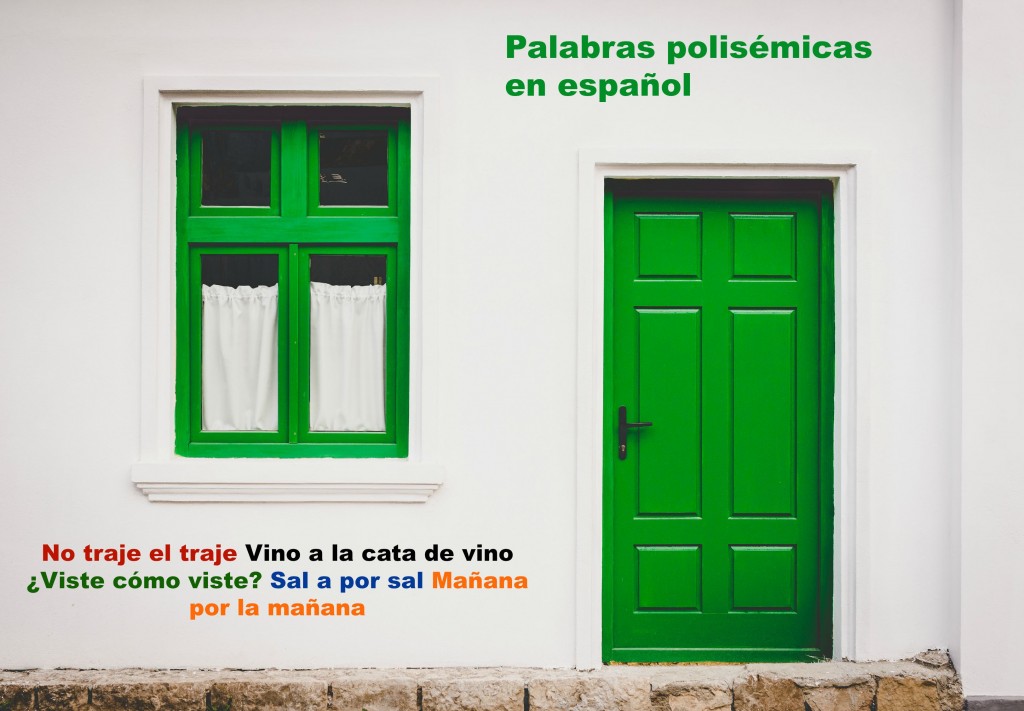Palabras polisémicas en español – Polysemy in Spanish: word choice matters
- Palabras polisémicas en español
Una palabra es polisémica si tiene varios significados pero un único significante. En español ocurre a menudo que se utiliza la misma palabra dos veces en la misma oración, dando lugar a frases bastante curiosas que pueden llamar la atención del estudiante de español. He aquí algunos ejemplos ¿Se te ocurre alguno más? ¡Compártelo con nosotros!
Polysemy is the existence of several meanings in a single word. In Spanish happens that the same word is used twice in the same sentence, leading to rather funny phrases that can be somewhat confusing for the student of Spanish. Here are some examples. Can you think of more sentences in Spanish like these? Share it with us!
No traje el traje – I didn’t bring the suit
Mañana por la mañana – Tomorrow morning
Olvidé la bolsa en la Bolsa – I forgot my bag in the stock exchange
¿Se cura el cura? – Is the priest healing?
Te he dado el dado – I have give you the dice
Me regaló un imán del Imán para la nevera – He gave me a magnet of the Iman for the fridge
Estoy sentado en el banco frente al banco – I am sitting on the bench in front of the bank
Un mono muy mono vestido con un mono de trabajo – A very cute monkey dressed with overalls
El chico bajo es el que toca el bajo – The short guy is the one playing the bass
Bota esa bota – Throw away that boot
Sal a por sal, por favor – Get out to buy some salt, please
¿Viste cómo viste? – Did you see how she dress?
Vino a la cata de vino – He came to the wine tasting
El español es un idioma, no veintidós / Spanish is one language, not twenty-two
Muchos estudiantes de español en Estados Unidos suelen preguntar cuál es el mejor español que deben aprender, como si existiesen mejores y peores versiones del idioma. Las buenas noticias para estos estudiantes es que el español es un solo idioma, y no veintidós (el número de países donde el español es el idioma oficial).
Al igual que el inglés, el español se habla en varios países. Y, tal como ocurre con el inglés, existen variantes locales. Sin embargo, las diferencias entre estas variantes no son tan importantes como para considerarlas dialectos.
Del mismo modo quIe un estadounidense entiende perfectamente a un australiano o a un británico, pero no habla igual que ellos, un hispanohablante entiende a todos los demás. Cada país hispanohablante tiene su propia variante del idioma, pero en general estas variantes tienen más similitudes que diferencias.
Pero más a menudo de lo deseable nos encontramos con escuelas o herramientas de aprendizaje en línea que ofrecen cursos de español diferenciados bajo los nombre de “español de España” y “español de América Latina”. Incluso es fácil encontrar esta distinción en procesadores de texto muy populares que todos utilizamos rutinariamente. Pues bien, esta diferenciación es, como mucho, una media verdad.
Como es bien sabido, América Latina no es un país, sin muchos (concretamente son 19 los que hablan español), y en cada uno de ellos podemos encontrar diferencias en su habla (Argentina, México, Colombia, etc., cada uno tiene su particular variante). Lo mismo sucede con algunas variantes del inglés en Estados Unidos y eso no significa que sean diferentes dialectos o que una sea mejor que otra.
En segundo lugar, la pronunciación del español es muy consistente. Más incluso que la del inglés. ¿Sorprendidos? Lo cierto es que entre regiones hispanohablantes hay menos diferencias que entre regiones anglohablantes. Las diferencias más destacadas en pronunciación son las ya conocidas por todos: la pronunciación de la “z” y la “c” en ciertas partes de España, que en América Latina se pronuncian como una “s”.
No obstante, es justo destacar que también existen algunas diferencias más importantes. Especialmente en vocabulario. Algunas palabras tienen significados diferentes en diferentes regiones, no sólo es un tema de España y América Latina.
Otro asunto diferenciador es el uso de la conjugación del “vosotros”, que se usa en España pero no en América Latina, donde usan “ustedes”. Pero la realidad es que está diferencia se ha magnificado demasiado. La experiencia del Instituto Cervantes indica que los estudiantes no tienen ningún problema para aprender ambas formas.
En conclusión: no importa qué variante del español se estudie, ya que al final será la herramienta perfecta para comunicarse con los hispanohablantes de todo el mundo. Porque el español, como cualquier otra lengua, es esencialmente una herramienta extremadamente flexible para entendernos los unos a los otros sin importar nuestra nacionalidad o cultura.
————————————————————————————————————————————————————————–
At some point, many students of Spanish in the US have asked the question above and wondered whether the Spanish they have heard is the “real” Spanish or just a dialect. Well, we have good news for you: Spanish is one language, not twenty two (the number of countries where Spanish is an official language).
Like English, Spanish is spoken in many different countries. And just as it happens with English, there are local variants – though the differences are not so great that they become different dialects.
If you are from the United States, you can understand an Australian or a British person, right? But you don’t speak like them. The same happens with Spanish. Each Spanish-speaking nation speaks its own variety of Spanish, but overall they have more similarities than differences.
More often than it should be, you probably have come across some language schools or online tools in the US offering differentiated Spanish courses under «Spanish (Spain)» and «Spanish (Latin America)». You can even find this differentiation in very famous word processors, for example. Well, at most, this is a half-truth.
Firstly, as you well know, the Spanish speaking Latin America is not one country but nineteen, and you can find differences between them in the same way that you can notice different English variants between states in the US.
And secondly, Spanish pronunciation is pretty consistent, much more than the pronunciation of English. That is, the differences in pronunciation, from region to region, are less for Spanish than they are for English. Surprised? The most noticeable difference regarding pronunciation in Spain as compared to Latin America is the pronunciation of the letters «z» and «c» – which in Latin America are pronounced like the letter «s» but in Spain are pronounced like «th». For the majority of students this difference is minor and of little consequence.
However, it is fair to say that there are also bigger variations, especially in vocabulary. Certain words carry different meanings in different areas. Not just Spain vs. Latin America, but region to region. The same is true regarding certain expressions; some are used in some regions, and others are used in different regions.
Another issue is the «vosotros» conjugation, which is used in Spain, but not in Latin America, where they use “ustedes”. The reality is that too much is made out of this issue. The experience at Instituto Cervantes says that students understand easily both forms.
The Bottom Line
No matter which variant of Spanish a student learns, at the end of the day it’s going to be the perfect tool to communicate with Spanish speakers all over the world. Because Spanish as any other language is just a tool, a very flexible tool, to understand each other regardless of nationality or background.
Aprende español y disfruta de la cultura española con nuestros cursos intensivos / Learn Spanish and love Spanish Culture with our intensive courses
El español es la primera lengua de 21 países; es una lengua en expansión, un trampolín profesional particularmente aquí en Estados Unidos y el idioma que te permitirá conocer y disfrutar más de cerca la cultura de los países hispánicos.
El próximo martes y miércoles 5 y 6 de noviembre comienzan los cursos intensivos de español en el Instituto Cervantes. ¿En qué consisten? Son cursos de 3 horas semanales en los que aprenderás o reforzarás los distintos ámbitos de la lengua española: gramática, escritura, lectura y habla. ¡Sí, todavía estás a tiempo de registrarte! Te contamos cómo.
Puedes realizar tu inscripción de manera online, telefónica o en persona.
■ Para registrarte online pincha aquí https://activenet16.active.com/institutocervantes/
■ Por teléfono 212.308.7720 ExT. 3
■ En persona en nuestra dirección Instituto Cervantes 211 East 49th Street New York, NY 10017. S
Para asegurarte que eres colocado en el nivel adecuado, antes de registrarte si no has estudiado con nosotros previamente, deberás realizar una prueba de nivel en nuestro centro de 9 a 17 h de lunes a jueves y los viernes de 9 a 15 h. Para ello, puedes pedir cita por teléfono o en nuestro centro. Si lo prefieres, también puedes solicitar la parte escrita a través de la siguiente dirección classprogram@cervantes.org y acudir en persona sólo para realizar la prueba oral en el mismo horario indicado anteriormente.
Aquí puedes consultar los horarios de los diferentes niveles
En el Instituto Cervantes creemos que para aprender una lengua es necesario conocer la cultura. Por ello, ponemos a tu disposición a través de diferentes actividades las diferentes culturas del mundo hispano.
Te esperamos
(Siga leyendo esta entrada…)


